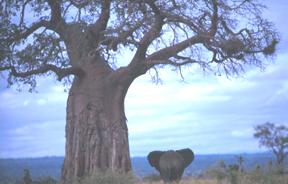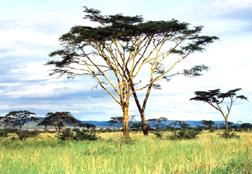|
Tropical Savannah:
Plants
Grasses are the
dominant plant life in the savanna. A wide variety of grasses grow
in savannas, but different varieties are found in different savannas.
Some grasses grow 6 to 9 feet tall.
Trees growing alone or
in small clusters are also part of the savanna biome. In fact, without
the trees, the savanna biome would be considered a prairie. The
variety of trees in a particular savanna is dependent upon the geographic
location of the savanna. The acacia and baobab trees are common
in African savannas.
Plant adaptations
In order for the
grasses to survive the dry season and the periodic fires, they have
developed an adaptation that allows them to grow quickly when there
is adequate water. Then when water becomes scarce, the grasses turn
brown to limit water loss. They store necessary moisture and nutrients
in their roots while they await the return of the rainy season.
With food and water reserves stored below ground, the grasses are
able to survive the effects of fire as well. In fact, fire stimulates
new growth and replenishes the soil with nutrients.

The baobab tree has adapted
to the savanna biome by only producing leaves during the wet season.
When leaves do grow, they are in tiny finger-like clusters. The
small size of the leaves helps limit water loss. Another adaptation
that enables the baobab tree to survive the long months of drought
is its ability to store water in its large trunk.
The acacia tree can survive
drought conditions because it has developed long tap roots that
can reach deep, ground water sources. It is also fire resistant.
Some varieties resprout from the root crown when the above ground
portion of the tree is damaged by fire. Fire is not the only hazard
faced by the acacia tree.
The acacia tree has developed
very useful physical and behavioral adaptations to discourage animals
from eating its leaves. It developed long, sharp thorns and a symbiotic
relationship with stinging ants. The ants live in acacia thorns
they have hollowed out, and they feed on the nectar produced by
the tree. When an animal takes a bite of leaves (and thorns), it
also gets a mouthful of angry, stinging ants. The ants defend their
homes from other insects as well, thus protecting the acacia tree.

Giraffes graze on the
tops of the acacia, which results in the dome-shaped top characteristic
of acadia trees. A behavioral adaptation aimed at preventing giraffe
grazing is a chemical defense system that is triggered when the
giraffe begins to munch on the leaves. First, a poisonous alkaloid
that tastes nasty is pumped into the leaves. The giraffe only gets
a couple of mouthfuls of leaves before the remaining leaves become
inedible. Then, the tree warns other acacia trees in the area by emitting a chemical into the air. The other acacia trees respond
by pumping alkaloid into their leaves. Photos
© 2000-www.arttoday.com
Back
|











